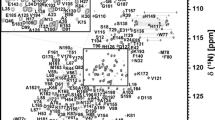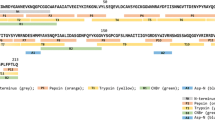Abstract
A cDNA encoding a cysteine protease inhibitor, cystatin was cloned from pineapple (Ananas comosus L.) stem. This clone was constructed into an expression vector and expressed in E. coli and purified to homogeneous. The recombinant pineapple cystatins (AcCYS) showed effectively inhibitory activity toward cysteine proteases including papain, bromelain, and cathepsin B. In order to unravel its inhibitory action from structural point of view, multidimensional heteronuclear NMR techniques were used to characterize the structure of AcCYS. The full 1H, 15N, and 13C resonance assignments of AcCYS were determined. The secondary structure of AcCYS was identified by using the assigned chemical shift of 1Hα, 13Cα, 13Cβ, and 13CO through the consensus chemical shift index (CSI). The results of CSI analysis suggest 5 β–strands (residues 45–47, 84–91, 94–104, 106–117, and 123–130) and one α–helix (residues 55–73).


Similar content being viewed by others
References
Abe K, Emori Y, Kondo H, Suzuki K, Arai S (1987) Molecular cloning of a cysteine proteinase inhibitor of rice (oryzacystatin). Homology with animal cystatins and transient expression in the ripening process of rice seeds. J Biol Chem 262:16793–16797
Arai S, Matsumoto I, Emori Y, Abe K (2002) Plant seed cystatins and their target enzymes of endogenous and exogenous origin. J Agric Food Chem 50:6612–6617
Belenghi B, Acconcia F, Trovato M, Perazzolli M, Bocedi A, Polticelli F, Ascenzi P, Delledonne M (2003) AtCYS1, a cystatin from Arabidopsis thaliana, suppresses hypersensitive cell death. Eur J Biochem 270:2593–2604
Callis J (1995) Regulation of protein degradation. Plant Cell 7:845–857
Gutierrez-Campos R, Torres-Acosta JA, Saucedo-Arias LJ, Gomez-Lim MA (1999) The use of cysteine proteinase inhibitors to engineer resistance against potyviruses in transgenic tobacco plants. Nat Biotechnol 17:1223–1226
Margis R, Reis EM, Villeret V (1998) Structural and phylogenetic relationships among plant and animal cystatins. Arch Biochem Biophys 359:24–30
Nissen MS, Kumar GN, Youn B, Knowles DB, Lam KS, Ballinger WJ, Knowles NR, Kang C (2009) Characterization of Solanum tuberosum multicystatin and its structural comparison with other cystatins. Plant Cell 21:861–875
Pernas M, Sanchez-Monge R, Salcedo G (2000) Biotic and abiotic stress can induce cystatin expression in chestnut. FEBS Lett 467:206–210
Shyu DJ, Chou WM, Yiu TJ, Lin CP, Tzen JT (2004a) Cloning, functional expression, and characterization of cystatin in sesame seed. J Agric Food Chem 52:1350–1356
Shyu DJ, Chyan CL, Tzen JT, Chou WM (2004b) Molecular cloning, expression, and functional characterization of a cystatin from pineapple stem. Biosci Biotechnol Biochem 68:1681–1689
Solomon M, Belenghi B, Delledonne M, Menachem E, Levine A (1999) The involvement of cysteine proteases and protease inhibitor genes in the regulation of programmed cell death in plants. Plant Cell 11:431–444
Turk B, Turk V, Turk D (1997) Structural and functional aspects of papain-like cysteine proteinases and their protein inhibitors. Biol Chem 378:141–150
Vray B, Hartmann S, Hoebeke J (2002) Immunomodulatory properties of cystatins. Cell Mol Life Sci 59:1503–1512
Wishart DS, Sykes BD (1994) Chemical shifts as a tool for structure determination. Methods Enzymol 239:363–392
Yang AH, Yeh KW (2005) Molecular cloning, recombinant gene expression, and antifungal activity of cystatin from taro (Colocasia esculenta cv. Kaosiung no. 1). Planta 221:493–501
Acknowledgments
This work was supported by research grants from National Science Council, Taiwan, NSC- 95-2113-M-259-005 and 96-2113-M-259-005 (to Chia-Lin Chyan).
Author information
Authors and Affiliations
Corresponding author
Rights and permissions
About this article
Cite this article
Irene, D., Chen, BJ., Lo, SH. et al. Resonance assignments and secondary structure of a phytocystatin from Ananas comosus . Biomol NMR Assign 6, 99–101 (2012). https://doi.org/10.1007/s12104-011-9334-1
Received:
Accepted:
Published:
Issue Date:
DOI: https://doi.org/10.1007/s12104-011-9334-1




